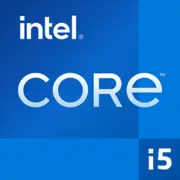Intel Core i5-13500HX

Intel Core i5-13500HX: Raptor Lake Power for Gaming and Work
March 2025
The Intel Core i5-13500HX processor, introduced in 2023, remains in demand in mid-range and high-end laptops. This chip combines a hybrid Raptor Lake architecture, 14 cores, and high energy efficiency, making it a versatile solution for various tasks. Let’s explore who this CPU is suitable for, how it performs in games and productivity applications, and what to consider when choosing a device.
Architecture and Manufacturing Process: Hybrid Cores and a New Level of Optimization
Heterogeneous Design: P-Core and E-Core
The Core i5-13500HX is built on a hybrid Raptor Lake architecture, which divides its cores into two types:
- 6 Performance-Cores (P-Core) with Hyper-Threading support (12 threads). The maximum frequency in Turbo Boost mode is 4.8 GHz. These cores handle "heavy" tasks such as rendering, gaming, and 3D modeling.
- 8 Efficient-Cores (E-Core) without Hyper-Threading (8 threads). They operate at a frequency of up to 3.5 GHz and are optimized for background processes: system updates, music streaming, and antivirus operations.
The total L3 cache size is 24 MB, which accelerates data processing in multi-threaded scenarios.
Intel 7 Process: Efficiency and Performance
The chip is manufactured using Intel's 10nm process technology known as Intel 7 (previously referred to as Enhanced SuperFin). Compared to Alder Lake (12th generation), Raptor Lake has improved energy efficiency by 15-20% due to transistor optimization and voltage reduction.
Integrated Graphics: For Basic Tasks
The integrated GPU is the Intel UHD Graphics for the 13th generation (32 EU, frequency up to 1.5 GHz). It supports:
- 8K HDR video;
- HDMI 2.1;
- Quick Sync technology (video encoding acceleration) and Adaptive Sync.
For gaming or working in graphic editing software, a discrete graphics card (such as the NVIDIA RTX 4050 or higher) will be required.
Power Consumption and TDP: Balancing Power and Battery Life
The nominal TDP of the processor is 55 W, but in turbo mode, the power consumption can temporarily reach 157 W. This necessitates an efficient cooling system, with most laptops using this CPU equipped with two fans and 4-5 heat pipes.
Energy-saving technologies:
- Intel Dynamic Tuning 3.0 — automatically adjusts frequencies based on workload.
- Speed Shift EPP — reduces latency when switching between tasks.
- C-States — disables unused cores during idle time.
For users concerned about battery life, we recommend selecting the "Power Saving" mode in the OS settings — this limits the frequency of the P-Core to 2.5 GHz, extending usage time.
Performance: Testing in Gaming, Rendering, and Office Work
Office Tasks and Multimedia
- Google Chrome (20 tabs) + Zoom + Excel: CPU load does not exceed 30%, thanks to the distribution of background processes on the E-Core.
- 4K Video Editing in DaVinci Resolve: Rendering a 10-minute project takes 8-9 minutes (compared to 12-13 minutes with the i5-12500H).
Gaming
In conjunction with an RTX 4060 (laptop version) and 16 GB DDR5:
- Cyberpunk 2077 (Ultra, DLSS Balanced): 65-70 FPS.
- Apex Legends (1440p): 120-140 FPS.
- Throttling: During extended sessions (1-2 hours), the P-Core frequency drops to 4.2 GHz due to overheating, but the FPS decreases only slightly (by 5-7%).
Turbo Mode: When Maximum Power Is Needed
When connected to power, Turbo Boost is activated automatically. For example, exporting video in Premiere Pro is accelerated by 25% compared to "Balanced" mode. However, this increases fan noise to 48 dB — it’s better to disable this mode for office use.
Use Case Scenarios: Who is the i5-13500HX Suitable For?
1. Gamers: When paired with an RTX 4060/4070 GPU.
2. Designers and Engineers: For work in AutoCAD, Blender, and Adobe Suite.
3. Students and Office Workers: Multitasking without delays.
Examples of 2025 Laptops:
- MSI Katana 15 B13V: $1299 (RTX 4060, 16 GB DDR5, 1 TB SSD).
- Lenovo Legion Pro 5i: $1399 (RTX 4070, 32 GB DDR5, 240 Hz display).
Battery Life: How Long Will the Battery Last?
With an 80 Wh battery capacity:
- Video Playback (1080p): Up to 7 hours.
- Working in Chrome + Office: 5-6 hours.
- Gaming Without Being Plugged In: 1-1.5 hours.
Tip: Choose laptops with Advanced Optimus (NVIDIA) or Switchable Graphics (AMD) to have the integrated graphics automatically enabled when running on battery.
Comparison with Competitors: AMD, Apple, and Previous Generations
- AMD Ryzen 7 7840HS (Zen 4): Better in multi-threaded tasks (for example, rendering is 10% faster), but lags in single-threaded performance (Geekbench 6 Single Core — 2100).
- Apple M3 Pro: More energy-efficient (up to 12 hours of battery life), but unsuitable for gaming and Windows software.
- Intel Core i7-13700HX: Only 15% more powerful but costs $200-300 more.
Pros and Cons
Strengths:
- High multi-threaded performance.
- Support for DDR5-5600 and PCIe 5.0.
- Optimization for Windows 11.
Weaknesses:
- Noisy cooling system under load.
- Integrated graphics are inadequate for modern gaming.
- Battery life is lower than that of the Ryzen 7 7840U.
Recommendations for Choosing a Laptop
1. Type of Device: Gaming models (ASUS ROG, MSI) or mobile workstations (Dell Precision).
2. Cooling: At least 2 fans + copper heat pipes.
3. Display: For gaming — 144 Hz or higher; for design — 100% sRGB.
4. Upgradeability: Choose models with two RAM slots and M.2 NVMe.
Final Verdict
The Core i5-13500HX is an ideal choice for those seeking a powerful laptop at a reasonable price ($1200-$1500). It can handle gaming, video editing, and engineering applications, but comes with compromises in weight (starting at 2.2 kg) and battery life. If you're looking for a balance between price and performance, this processor deserves your attention.
Basic
CPU Specifications
Memory Specifications
GPU Specifications
Miscellaneous
Benchmarks
Compared to Other CPU
Share in social media
Or Link To Us
<a href="https://cputronic.com/cpu/intel-core-i5-13500hx" target="_blank">Intel Core i5-13500HX</a>